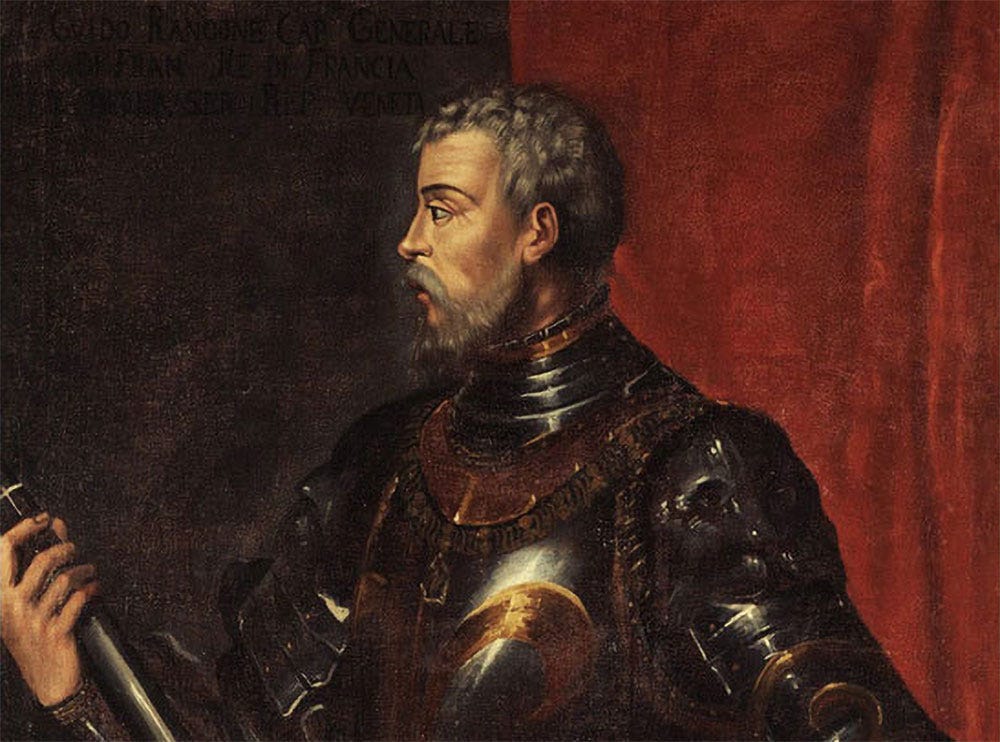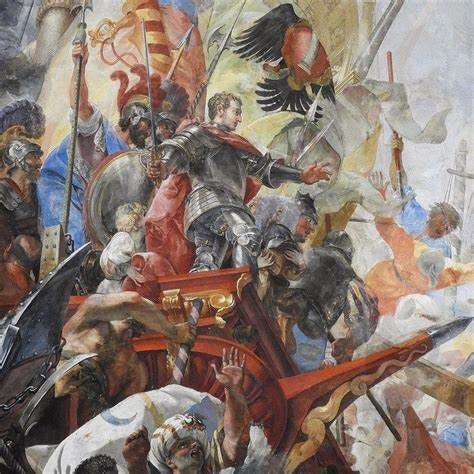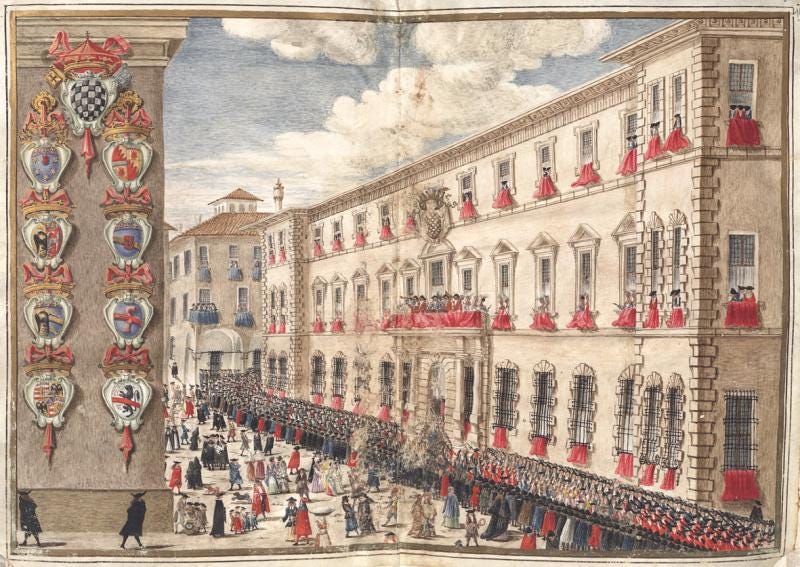I might be getting ahead of myself here, as I’ll have a detailed article about Filippo Bartolomeo Dardi coming out in the next few weeks, which will help illustrate—I hope—a deeper pedagogical existence of the Bolognese system of fencing as it relates to the Bentivoglio family. Before I get there, I wanted to talk about another rabbit hole I’ve been digging around in, a rabbit hole I believe builds on the Dardi legacy. If you want a taste of what’s coming, check out the lecture I gave last weekend at Queens Gambit in Charlotte, North Carolina. If you're here for the ride—strap in.
When we see names like Viggiani, Malvezzi, Marescotti (Marscotto), Pepoli, Ghisilieri, dall’Agocchie, Achillini, crop up in texts 99% of you will just think—eh, some guy in Italy. That’s fair, I used to too, until I started to learn more about the families that comprised the noble guilds, and leading classes; the Docturi and Cavalieri, in Bologna. Understanding Bolognese history has changed my understanding of Bolognese historical fencing—go figure.
The upper echelon of Bolognese society was comprised to three elements, Docturi; Academics from the University of Bologna, Cavalieri or Knights, and the four notable or noble guilds; which were the Notai (Lawyers), Cambiatori (Bankers), Drapieri (Cloth Merchants), and Arte Serica (Silk Merchants). A Bolognese citizen was also considered noble if they had a Knight or a Doctor in the family in the last 30 years, and did not pursue a manual craft or trade, or were members of one of the four noble guilds.
Those familiar with Northern Italian fencing might’ve already seen a few familiar names pop up in the list of families I mentioned above. Let me list some more of the Bolognese noble families and their guilds or titles, and then let’s bring in our fencing authors to draw out some further connections.
Bentivoglio (Notai) {Signoria periodically between 1401-1445, then supreme from 1445-1506}
Pepoli (Cambiatori)
Malvezzi (Arte Serica)
Marescotti (Drappieri)
Achillini (Docturi)
Canetoli (Notai) {Challenged for Signoria between 1420-1445}
Foscherari (Cambiatori)
Gozzadini (Cambiatori)
Zambeccari (Notai) {Signoria from 1397-1401}
Fantuzzi (Cambiatori)
Ghislieri (Cavalieri)
Vizzani (Cavalieri)
Now let’s take our Northern Italian Fencing authors one at a time, and I’ll give a brief historical background that ties each of the fencing authors or their patrons, or their students to the Bentivoglio chronical.
Giovanni dall’Agocchie: Giovanni dedicated his treatise, Dell'Arte di Scrima Libri Tre to Fabio Pepoli in 1572, Fabio was the descendant of Taddeo Pepoli, the first Signoria of Bologna. The Scacchessi faction in Bologna between 1350-1420 took the Pepoli coat of arms as its symbol. While the Pepoli family were loyal Guelfs, and supported Pope Julius II in the removal of the Bentivogleschi from Bologna, they had, until 1449 been loyal supporters of the Bentivoglio family, when they led a revolt along with the Zambeccari and Fantuzzi families. The dall’Agocchie family too were courtiers of the Bentivoglio family, and fled Bologna with the family in 1506. Going back to the Pepoli family, it’s worth mentioning that Giovanni Pepoli, born in 1521, the son of Filippo Pepoli and Elena Fantuzzi (it’s a conspiracy—well their families attempted a coup together in 1448), married below his station—a shock to the legacy of Pepoli, how could he—taking for his wife a commoner, a woman whose name was Vincenza Manciolino (Manzolini)1. I wonder why he would have the gall to degrade himself thus.
Achille Marozzo: Marozzo dedicated his treatise, Opera Nova, to Guido Rangoni, the grandson of Giovanni II Bentivoglio, in 1536. Guido Rangoni’s father Niccolo Rangoni was the captain of Giovanni II Bentivoglio’s standing army of 200 men-at-arms in Bologna. Marozzo talks about how both he and Guido Rangoni studied under the fencing master Guido Antonio di Luca, who took up residence in Bologna in 1496, the same year that Annibale II Bentivoglio, Guido’s uncle, started a school for the training of arms in Bologna, called il Casino, and according to Gelli was ‘under the protection of the Bentivoglio’. Besides heralding that he trained under the fencing master of the Bentivoglio, one of Marozzo’s famed students was Emilio Marescotti (Marscotto), the Marescotti were loyal Bentivogleschi until 1501, when the Marescotti were implicated in a conspiracy to hand lordship of Bologna to Cesare Borgia. The surviving Marescotti came back to Bologna in 1506 when Pope Julius II removed the Bentivoglio from power. Emilio Marescotti eventually reconciled and became an ally of Guido Rangoni during his campaigns against Ferrara in Modena. The Marescotti were one of the most important allies of the Bentivoglio in Bologna, and the great Galeazzo Marescotti was one of the most revered citizens of Bologna for almost a century. The Marescotti were Knights and courtiers of the Bentivoglio.
Giovanni Fioloteo Achillini: Both Giovanni and his brother Alessandro were Docturi. Alessandro Achillini is known as being a courtier of the Bentivoglio, and fled with the family in 1506, breifly taking a position at the university of Padua, before returning to Bologna, where he spent his remaining years. Giovanni spent his youth as a courtier, poet, and linguist traveling between Milan, Ferrara and Bologna. He would later serve seven terms in the civil authority of Bologna (1513, 1516, 1522, 1524 and 1537), the Anziani, being named to the highest office of civic leadership, the Gonfalonieri del Popolo in 1527. Achillini published Contezza del Viridario, a peom which has passages describing sword and buckler fencing and refers to a young 19-year-old Guido Rangoni thus, “How and in delicate acts they are, his youth has no equal life, happy and here engulfed in sweet anguish, now I affirm his virtue.”
Angelo Viggiani: Viggiani discusses Ugo Pepoli and Guido Rangoni who were longtime rivals, then allies, until they fell out and fought a duel with one another in 1516, before being forced to reconcile in the face of Charles V forces in 1526. He also mentions his muse Conte d’Agomonte staying in Bologna with the loyal Ghibilline Emilio Malvezzi, while his primary muse Luigi Rodomonte Gonzaga stays with Conte Ugo Pepoli and the third voice in his dialogue is that of Lodovico Boccadiferro who was a student of Alessandro Achillini. The Vizzani family is an old family in the city of Bologna. A member of the Vizzani family accompanied Sante Bentivoglio, as a courtier, to visit the Pope in 1447, and the family amassed enough wealth to buy the Lamertini Castle in San Giovanni del Monte in the mid-16th century.
Girolamo Cavalcabo: A later publication of Viggiani’s lo Schermo published by Zachara Cavalcabo in 1588, possibly the father2 or a relative of Girolamo Cavalcabo, was dedicated to Pirro Malvezzi, rather than Charles V or Maximilian II, Holy Roman Emperors, as in previous publications. The Malvezzi were the other key ally of the Bentivoglio until their defection in 1488 (the families were bound by matrimony in 1420), when they were exiled from Bologna. Lucio Malvezzi was the mercenary captain under whom Gudio Rangoni cut his teeth as a captain in Venetian service after the Bentivoglio exile, and his uncle’s (Annibale II and Ermes) defection to the French. The Malvezzi, Guido Rangoni, and the Bentivoglio reconciled in 1509, and rekindled the family’s historical alliance. Emilio and Pirro Malvezzi both made their way into Bolognese Fencing treatises. Girolamo Cavalcabo himself would publish a treatise on fencing in the 1580’s, called Nobilissimo discorso intorno il schermo. After his publication he was invited to become the fencing master in the court of Henry IV. Pirro Malvezzi, the patron of this later Viggiani publication, was an Italian hero who had fought on behalf of the French Crown against the Huguenots in the French Wars of Religion at the battle of Montcontour, the same expedition that saw Francesco Ghislieri, father of Federico Ghislieri earn tremendous honor but ultimately lose his life, before returning home to stand beside Marcantonio Colonna at the battle of Lepanto. Pirro finished his illustrious career as a courtier of Phillip II, Holy Roman Emperor, who granted him the title of Governor of Milan.
Federico Fabio Ghislieri: The Ghislieri family is one of the oldest noble families in Bologna. Traditionally a part of the Lambertazzi faction, the Ghislieri often found themselves in a position of great importance in Bolognese civic discourse. One Ugolino Ghislieri was knighted by Giovanni I Bentivoglio in 1401. The family though not always agreeing with the Bentivoglio, were often allied with the Bentivoglio until 1448, when they stood in open rebellion with the other ancient families of Bologna the Pepoli, Fantuzzi and Zambeccari. They would return to Bologna in 1506 with Pope Julius II. While exiled from Bologna the family would eventually split and form distinct Roman and Bolognese lineages. Federico was the scion of the Bolognese Branch.
Pepoli, Marescotti, Malvezzi, Ghislieri, Vizzani, Achillini, Rangoni, Fantuzi; what do they all have in common with one another? A shared patronage as courtiers, knights, and family members of the Bentivoglio. Some became enemies, and formed new factions outside of the sphere of the Bentivogleschi, but until 1448 (the enshrinement of Sante Bentivoglio) their core loyalty was to the great patrons of the Bentivoglio line; Giovanni, Antongaleazzo, and Annibale. These would also be the scions who were contemporaries of Dardi—maybe there’s more to this Dardi fellow after all—I guess I wasn’t getting ahead of myself, just setting up what’s about to happen next, when we get our hands dirty digging through the origins of the Bentivoglio Family and how that history ties into the life of Filippo Bartolomeo Dardi.
PEPOLI, Giovanni in "Dizionario Biografico" (treccani.it)
This according to Edgerton Castle,






